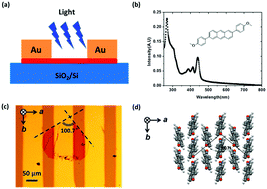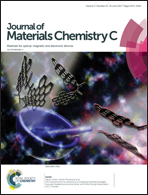Highly responsive phototransistors based on 2,6-bis(4-methoxyphenyl)anthracene single crystal†
Abstract
Herein, thin film and single crystal phototransistors based on 2,6-bis(4-methoxyphenyl)anthracene (BOPAnt) are systematically studied. High quality BOPAnt single crystals are grown via the PVT (physical vapor transport) method to fabricate bottom gate top contact phototransistors. The thin film phototransistor shows a photoresponsivity of 9.75 A W−1 under 1 mW cm−2 blue LED illumination, whereas under the same conditions the single crystal based phototransistor displays a photoresponsivity of 414 A W−1. Furthermore, using low power monochromatic light with the wavelength of 350 nm, the photoresponsivity of 3100 A W−1 under 0.11 mW cm−2 illumination and EQE of 9.5 × 105% are obtained for the BOPAnt single crystal phototransistor with the channel length of 65 μm. The much higher photoresponsivity of the single crystal based phototransistor is due to its much higher exciton diffusion length compared to that of the thin film device, which is also evident by the large Von shift towards the positive voltage direction. The photoswitching behaviors of the single crystal based phototransistor are also studied. It is observed that after a short warming up period, the single crystal based phototransistor shows stable switching behavior.



 Please wait while we load your content...
Please wait while we load your content...